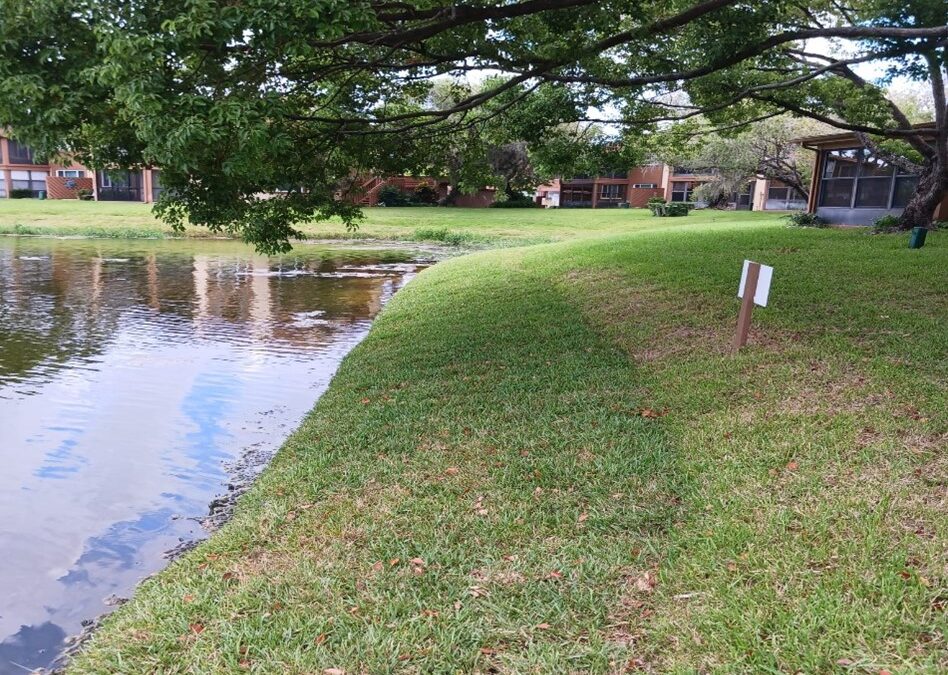For over 20 years, Landshore® has used variations of geotubes across a variety of projects. Our teams have engineered works ranging from riverbank stabilization to homeowner land reclamation. They’re often known for their sod to waterline aesthetic, frequently seen at golf courses and homeowners associations. When the conditions are right, a geotube installation can be a cost-effective and an aesthetically pleasing erosion control product.
Geotubes, also known as geotextile tubes or geotextile containers, are large fabric tubes filled with sediment, soil, or other materials to create a temporary or permanent barrier for erosion control and shoreline protection. At Landshore®, we utilize a self-designed Eco-Filter Tube to meet our project needs.
Here are some key points about the use of geotubes for erosion control:
- Erosion Protection: Geotubes are commonly employed in coastal areas, riverbanks, and shorelines to provide protection against erosion caused by wave action, currents, and water flow. They are particularly useful in areas where traditional hard structures like concrete walls or rock revetments are not feasible.
- Construction and Material: Geotubes are typically made of high-strength, permeable geotextile fabric that allows water to pass through while retaining the contained fill material. The fabric is designed to be durable and resistant to ultraviolet (UV) degradation and chemical exposure.
- Installation: Geotubes are often installed parallel to the shoreline or along riverbanks, creating a protective barrier against erosive forces. They can be stacked vertically, depending on the specific application and site conditions. Proper installation techniques are critical to ensure the stability and effectiveness of the geotube system.
- Fill Material: Geotubes are filled with locally available sediment, soil, or other appropriate materials. The fill material should be properly selected to provide sufficient weight, stability, and resistance to erosion. It is essential to consider the compatibility of the fill material with the geotextile fabric and the hydraulic conditions at the site. Often, the use of appropriate fill can make or break a project. Some operators may select fill from the site that’s convenient, but lacking in stability. In these scenarios, a lack of stability can weaken a geo-tube’s effectiveness or result in continued erosion. Here’s a pro-tip: Have your contractor perform soil tests on-site or source material receipts to be used from a local quarry. Landshore’s engineering team is a great resource for determining soil stability and determining appropriate fill requirements.
- Vegetation and Stabilization: Geotubes can be used as a temporary measure or as a foundation for establishing vegetation. Vegetation, such as grasses or other erosion-resistant plants, can be planted on the exposed surface of the geotubes to enhance stability, increase root reinforcement, and provide additional erosion control benefits.
- Monitoring and Maintenance: Regular monitoring and maintenance are essential for geotube systems. Inspections should be conducted to identify signs of damage, settlement, or erosion. If necessary, repairs or additional fill material may be required to maintain the integrity of the geotubes.
It is important to note that the use of geotubes for erosion control should be based on site-specific conditions, engineering analysis, and local regulations. Geotube systems are not suitable for all situations, and their application requires proper design, installation, and monitoring to ensure effectiveness and long-term stability. Consulting with a qualified geotechnical or environmental engineer is recommended to determine the suitability and design requirements for utilizing geotubes in erosion control projects.
If you have any questions or concerns about your geotube project, we encourage you to reach out to Landshore. Our team of experts is ready to review your specific challenges and assist you in finding the best possible solutions. For more valuable insights and updates from our engineering team, be sure to follow us on our social media channels listed below. We look forward to connecting with you and helping you alleviate your erosion challenge.

